Interview With
Sik Willy Miniature Art

Sik_willy_miniature_art or Will Hahn’s journey into the world of miniature painting began with a childhood fascination for Warhammer and blossomed into a serious hobby. Known for his versatility and ability to employ a wide array of techniques (especially freehand), Hahn’s intricate works are lauded for their color mastery and attention to detail. From Golden Demon to Monte San Savino, his achievements in the field have made him a respected figure, as well as an artist whose passion for miniature painting continually evolves, most recently towards display painting.
So without further ado, let’s delve into the mind of Will Hahn and explore his unique perspectives on miniature painting, techniques, and the art that has shaped his life.
1. Interview with Sik Willy Miniature Art: How did you start with miniature painting?
I started painting, like many others in the community, with Warhammer. I had first been exposed to it as a kid while visiting some family friends in Germany. At that point, there weren’t too many places around my area that had it, nor many kids my age that knew of it. A few years later, I was at a local store where we would get our Magic the Gathering cards and comic books, when I noticed the new Warhammer display. I fell in love with the Lizardmen faction and after a few weeks of begging I had convinced my mother to buy the 5th edition Fantasy battles starter set for my brother and I as a Christmas gift. I played for several years, always enjoying the painting aspect as much as the gaming, and even entered Golden Demon at the Baltimore Gamesday in 2000 as a youngblood where I was a finalist.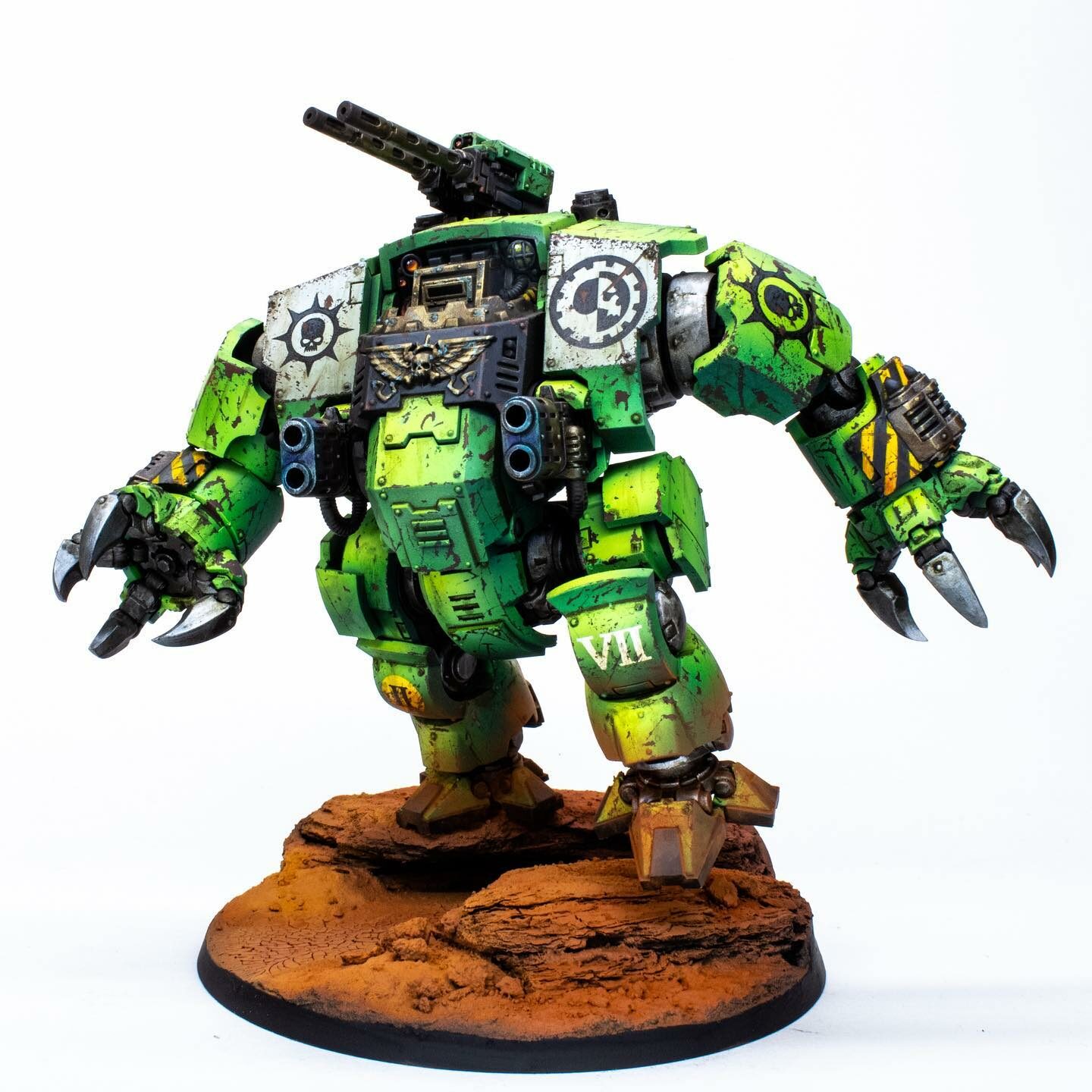
When I started to hit my early teen years my focus shifted (sports and girls) and I hung up the brushes. Many years later, in 2015, I was diagnosed with Chronic Lyme disease. The severity of it increased over the next couple years, and hit its peak in about 2017. I was physically unable to do all of the things I normally enjoyed, and was undergoing treatment for 5-6 hours a day stuck at home in my house. I was going stir crazy, and needed an outlet. Somehow Warhammer popped into my mind and I found out that I had a Games Workshop close by.
I was immediately hooked again and started painting and gaming again as my outlet. It really saved me in a way during one of the darkest times in my life. During Covid, since I could no longer game with my friends, I shifted once again towards display painting, and that’s pretty much what has lead me to where I am now.
2. What is your favourite painting technique?
Hmm….that’s a hard question! I don’t necessarily have a favorite. I use a wide array of techniques, as I feel like they all have strengths and weaknesses, and they each have a place and typically produce a specific result. I think people should try to have a good handle on just about any brush technique. I use layering, wet blending, sketching, my airbrush, glazing, and sometimes pigments, enamels, and oils. It all depends on your desired result.
I would say if there was one technique to rule them all, it would be layering, it’s the most versatile.

3. What is your favourite miniature that you have painted?
Another hard question! I’m not good at picking favorites of anything. I would probably say it’s between Scarlet and The Dreamer. I had specific visions in mind for both of them as soon as I saw the sculpts. I’m also particularly proud of the color work on both of them.
Scarlet is probably my most well known piece, I think the amalgamation of a lot of decisions on that one turned it into something special. Most people think that the mini is basically black, white, and red- but it’s not. Her skin, the marble, everything aside from the red is made up of tonal greys with hints of greens, blues, purples, and even very subtle flesh tones. Most people are stricken by the red so the rest of it (which took way more work) gets lost subconsciously. But if it wasn’t there, the piece wouldn’t look the same at all and it wouldn’t work.
The Dreamer was a box art for the Reina Roja Miniatures Kickstarter on the Art of Gary Villareal. I loved the miniature as soon as I saw it, and it offered me an opportunity to play with a lot of vibrant colors I wouldn’t otherwise cram into a piece. The thing I love most about this piece is the true ultramarine shawl around her head. Creating luminosity in a non-luminous color was a serious challenge, and I think I pulled off pretty well.
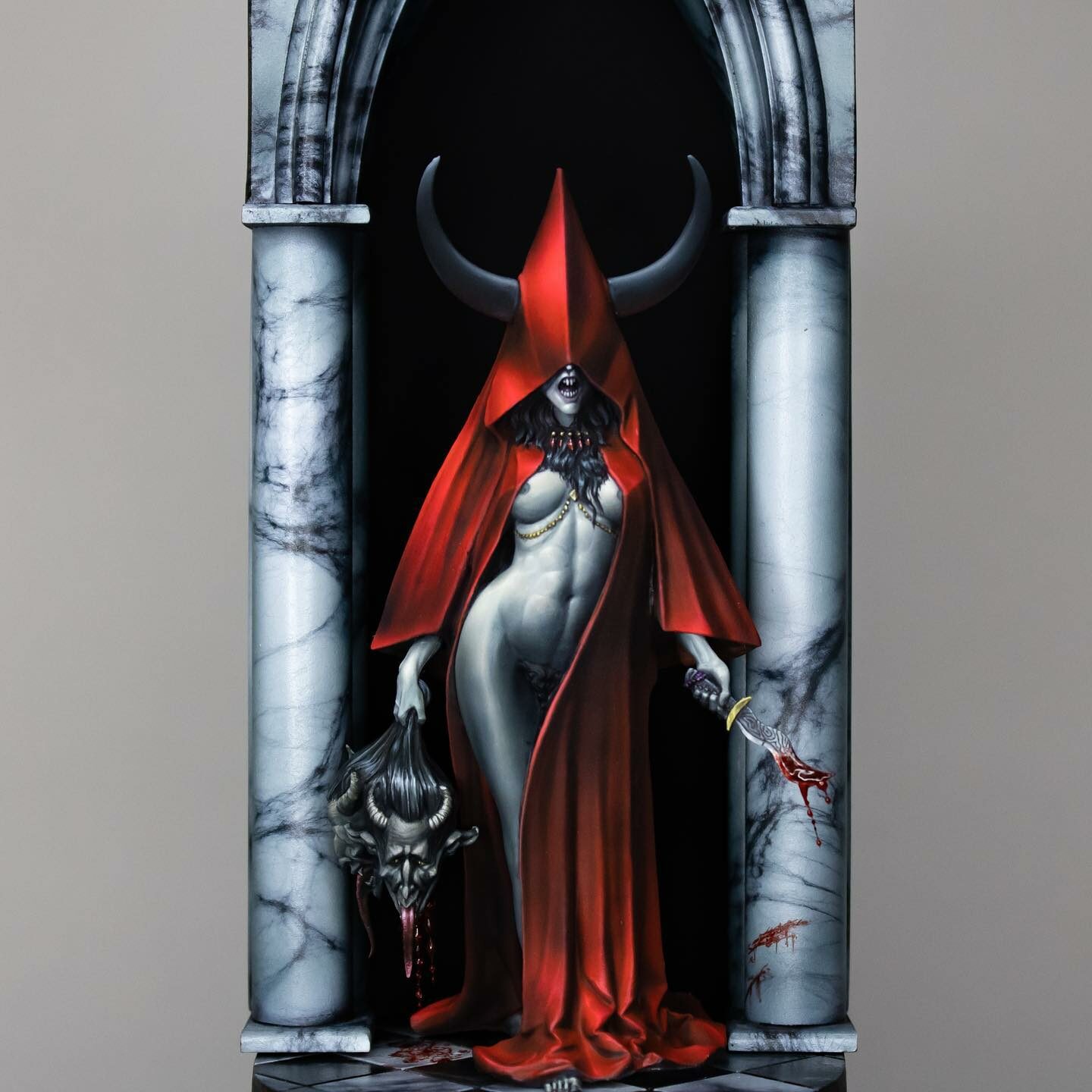
4. What is the key tip you would give to a miniature painter who wants to improve?
I’ll leave a couple here… The foremost thing is to get out of your comfort zone. That’s where learning happens. If you do the same thing over and over, you just get really good at doing that one particular thing. You need to constantly add new challenges to see constant improvement.
Next, knowledge is just as important as practice. They go hand in hand. Consume as much theory as your brain can handle, and then apply it while you’re painting. And make sure that knowledge is good knowledge. Not all sources are equally valuable, same thing with feedback. If you’re practicing the wrong thing without realizing it, you’re actively working against your own progress.
Lastly, don’t fear mistakes. Every mistake is a learning opportunity. They are a part of the process, and the better you get at both identifying those mistakes and correcting them, the faster your progression will occur. This is a skill in itself – self diagnosis. Once you get a handle on this, your progression will accelerate drastically.

5. Interview with Sik Willy Miniature Art: What do you most enjoy about miniature painting?
I do enjoy most of the process, though there are always some parts it seems that you just have to push through to get the rest. But I think what I enjoy the most is the end product. That may seem odd, but I think it’s the sense of accomplishment when I actually finish something. I’m very bad at completing projects. For every finished piece I normally have about five that didn’t make the cut. I also think that there’s something really gratifying about seeing whatever vision I have come to fruition.
6. What is your proudest achievement to date?
Another hard one. I think I’m proud of all of them in a way. I would say any of my Best of Show awards are up there, so LVO (2nd and 3rds), Best of Fantasy at MFCA, Fan Favorite in the last ‘Eadbanger, and last year at Nova especially was pretty special. I went to Nova’s Capital Palette ’22 with 4 main entries, each of which won Best in Category for their respective categories, as well as Scarlet getting both Overall Best in Show and Fan Favorite.
I think I’m most proud of my Silver Medals at Monte San Savino and Golden Demon. Golden Demon mainly for the nostalgia, the style of the competition (1,2,3), and how I felt watching that as a kid playing Warhammer. Monte San Savino for the level of competition. It was the highest concentration of world class miniatures I’ve ever seen in a single location. Most shows you go to, there are a handful of entries that really stand out. At Monte, the entire field is just loaded with masterpieces. So to be recognized among the world’s best artists was an incredible feeling.
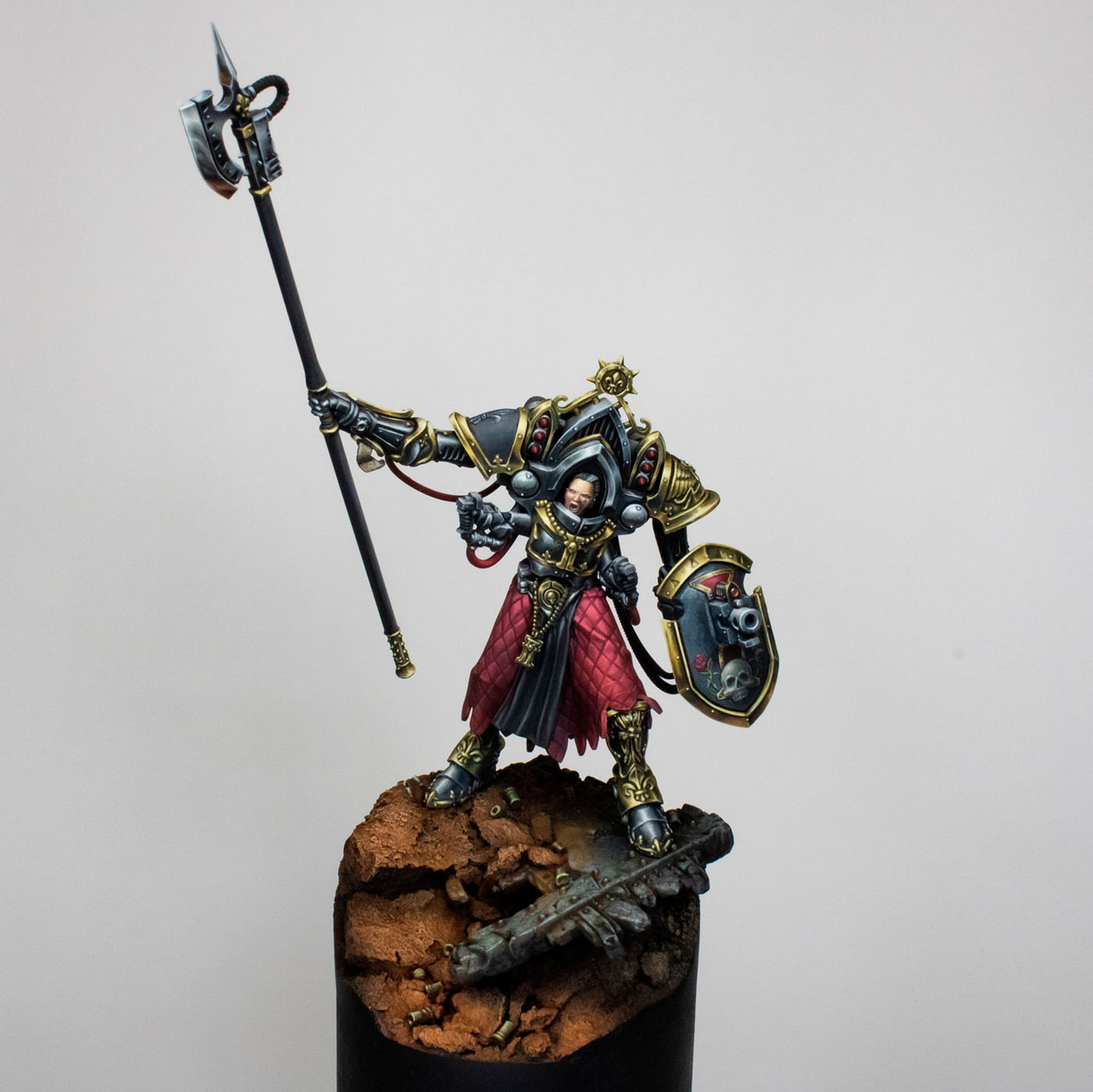
7. Who do you look up to in the miniature painting community?
A lot of people. I think we have an incredible community, filled with outstanding and good hearted people. I could make a list here a mile long. I’ll start with Alfonso “Banshee” Giraldes. He is definitely my most prominent mentor, and my art would not be what it is today without his tutelage. I don’t think our art form would be what it is today without his influence. Obviously many artists have driven and shaped miniature painting as an art, but I don’t think many people know how much influence he’s really had on what we do- especially newer painters. He’s probably, in my opinion, the most accomplished miniature art teacher of our time. A high percentage of top tier artists today have been his students at one point or another.
Erik Swinson is another. I consider Erik a good friend and really appreciate him on a personal level as well as artist. I think he was truly at the vanguard of bringing respect back to the American painting community and has definitively broken the tired stereotype of “Americans can’t paint as well as Europeans”. With that being said, I think that so many of these “national style” walls have been broken down. Our community is very global and should be treated as such. It’s art- you like it or you don’t.
There are so many artists out there that I look up to and appreciate on a stylistic level. I really appreciate people that are unique or do things differently. I’ll name another handful here, this is by no means an exhaustive list. Richard Gray (another mentor of mine) is probably hands down my favorite small scale painter. His freehand skills are something I always aspire to, he’s the benchmark in my mind. I love the storytelling and compositional skills of Chris Suhre and Roman Lappat, I feel their work speaks for itself. I love the impressionistic, unique style of Seyni N’Diaye. Aythami Alonso Torrent has always been another favorite of mine, something about his style just resonates with me- absolutely masterful control of broken tones. Albert Moreto Font, for being the utter pinnacle of precision, which always blows my mind. Arnau Lazaro, Marc Masclans, and Kiril Kanaev of course. All of their works really never cease to amaze me. I’ll stop here just for the sake of brevity (which I think I’ve already surpassed)

8. What was it like to enter Golden Demon? Would you enter again?
Golden Demon was really fun. It was nerve wracking, but fun- with an incredible blast of nostalgia added in. I started my entry very late last year, and burned the midnight oil for the 3 weeks leading up to the event to cram in an entry. I actually finished it in my hotel room 30 minutes before the entry deadline, but in the end it was worth it. It’s something that I think any Warhammer or Games Workshop fan should do at least once in their life, even if you don’t feel like you could win, you should go for the experience.
I would absolutely enter again. And I’ll enter any year that I can feasibly complete an entry. I don’t think I’ll rush an entry like last year again though- it was brutal and I used up a half year’s worth of brownie points with my wife to put in the studio hours- as well taking time off my day job. I think my plan for the future is to only enter if I know I can really make the project what I intend for it to be.
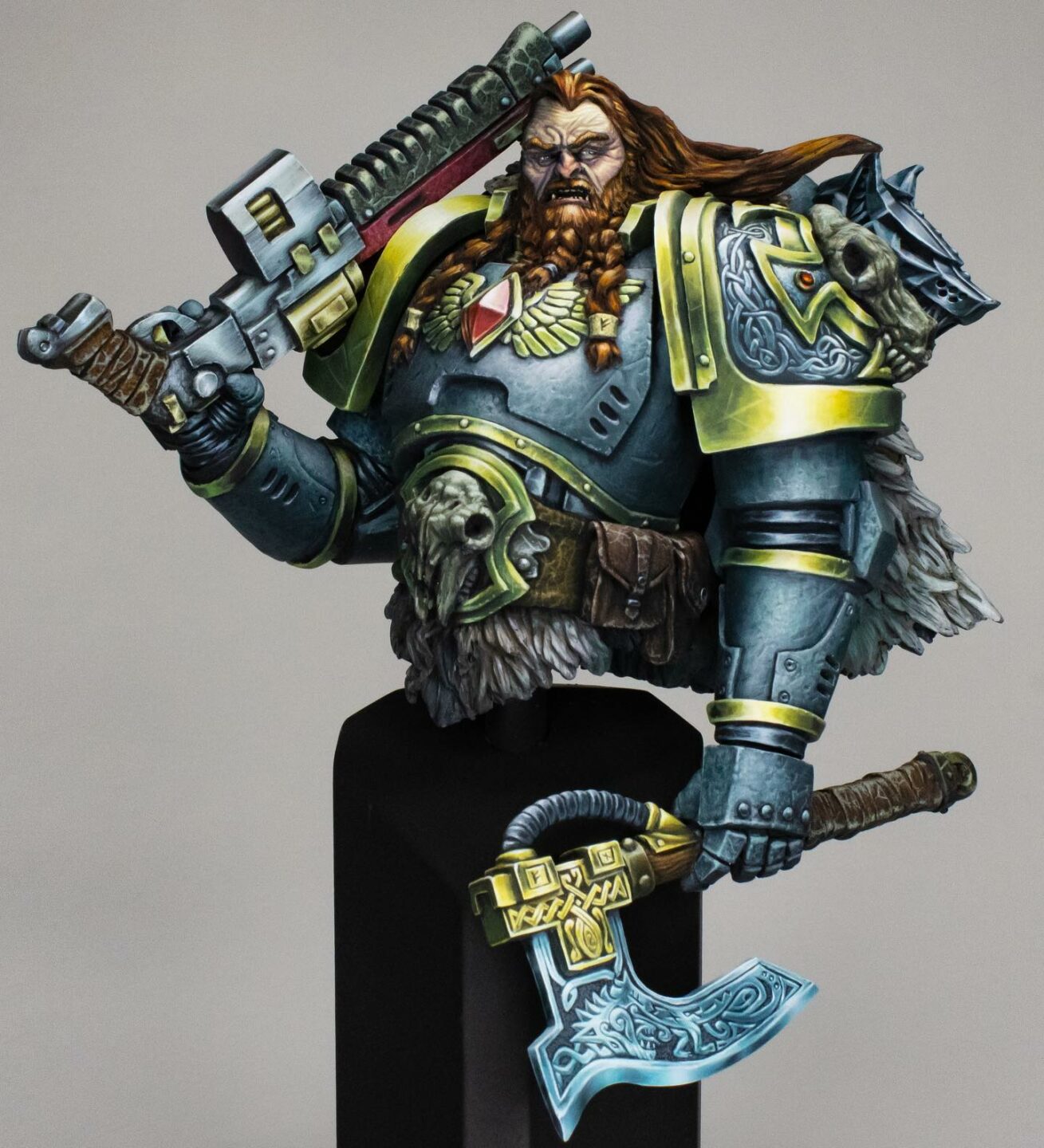
9. For those who would like to try freehand, what is a good starting point?
The starting point is your plan. ALWAYS go in with a plan. Get your design set first, and only take paint to model once you are absolutely sure that you know what you intend to do. Then you need to plain out your proportions (this is the hardest thing about freehand on miniatures). I like to make little marks around the edge of the design, and work within that space. You can also varnish your miniature, and then use something erasable like a sharp pencil or watercolors to sketch it out before applying your acrylics. Start with basic shapes first, and then work up to more complex designs. Freehand is something that often times you kind of just have to keep tinkering with it until it looks right, especially rendered freehand. So keep this in mind – if it doesn’t look right, it just means you aren’t done yet.
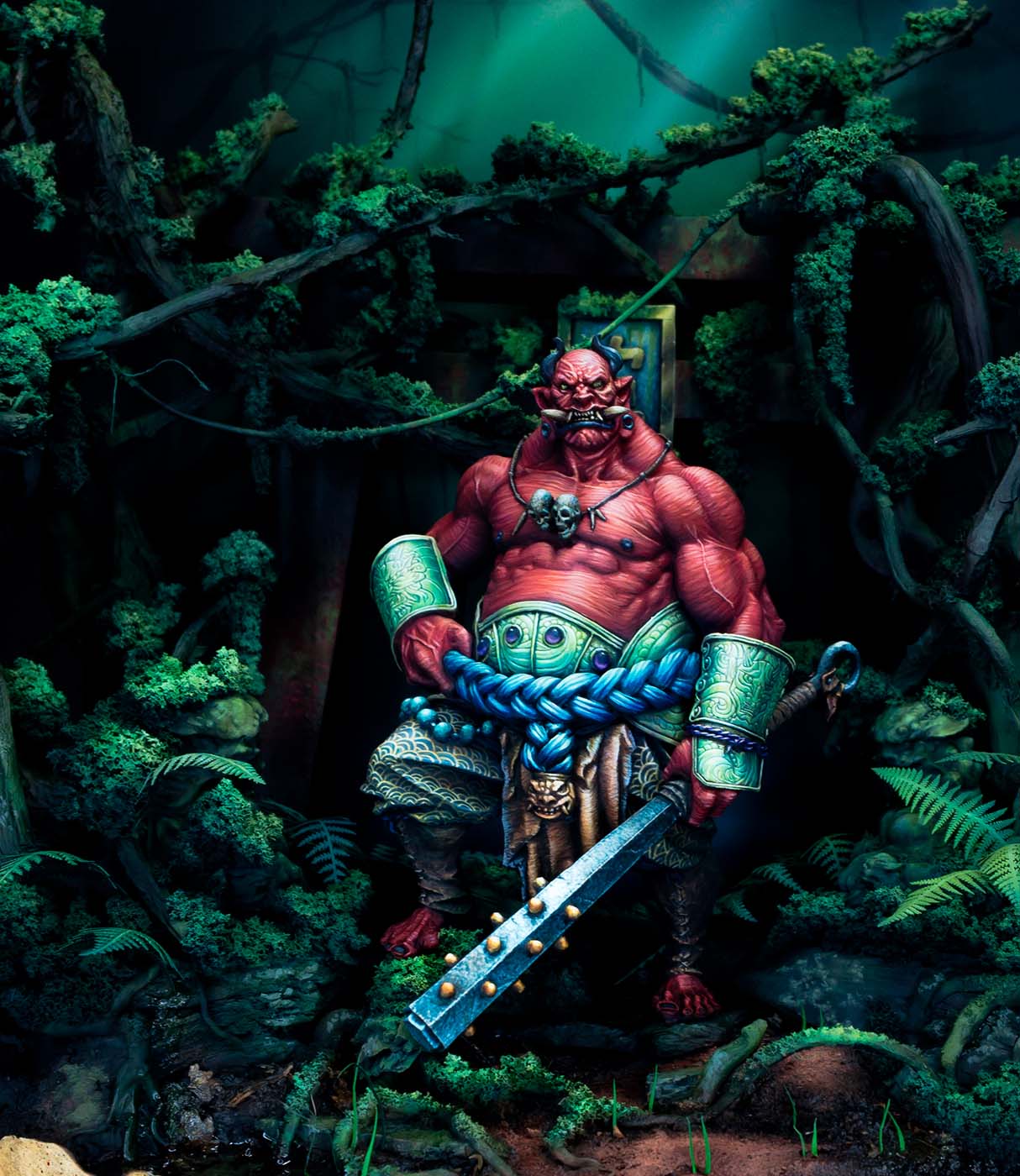
10. Interview with Sik Willy Miniature Art: Why is colour important to miniature painting?
It’s not only important, I would argue that it is THE most important thing in miniature painting. Color and value (light or dark) is the primary weapon in any miniature painter’s arsenal.
While traditional (2D) painters contend with volumes (shapes) as well, ours are already dictated on a sculpt- so being able to accentuate those already defined shapes with Hue (color) and value is of the utmost importance, and when you are skilled enough it actually allows you alter the sculpt itself just by placement of certain tones. I would argue that understanding of color is actually more important to a miniature painter than it is to a canvas painter.
